The Great Game- India vs China Part 2: Neighboring Countries and China's increasing influence
- In Military & Strategic Affairs
- 09:44 AM, Mar 22, 2018
- Mohal Joshi
In the first part of this article, the author talks about The Great Game- India vs China and if India was ready for the Chinese Challenge in its neighborhood. This next part will highlight each country/region across the IOR the Chinese & India moves & counter which is a part of this new “Great Game”.
PAKISTAN:
One of the biggest OBOR projects is in Pakistan referred to as CPEC (China Pakistan Economic Corridor). China has promised to invest $60 billion into developing rail lines, roads, power plants & development of the strategically located Gwadar port. The official stated goal of this biggest ever foreign investment in Pakistan is to “rapidly modernize Pakistani infrastructure and strengthen its economy by the construction of modern transportation networks, numerous energy projects, and special economic zones”. But as they say the devil is in the details. Recently “The Dawn” a newspaper in Pakistan reported that 91% of the income generated by the Gwadar port with go to China while the Gwadar Port Authority will get a measly 9%. With such a low return from the project it begs the question as to how the loan from this project will be repaid eventually. Later in the article I will give more examples of this so called “debt trap” where countries are unable to pay back the loan to China either due to insufficient returns or onerous terms of the loan. Many in Pakistan have slowly realizing that the terms of these loans from their so called “iron brother” & “all weather friend” are not in the best interests of Pakistan. This was demonstrated late last year when Pakistan asked China to exclude the $14 billion Diamer-Bhasha Dam from CPEC . They were reportedly unhappy with the strict conditions laid down for the project by China. Inspite of multiple Chinese denials, for India the worry is that Gwadar port will be eventually converted into a facility for docking Chinese naval ships which will give it strategic advantage overlooking not only the Strait of Hormuz but also open a new front against India from the west in the Arabian Sea.
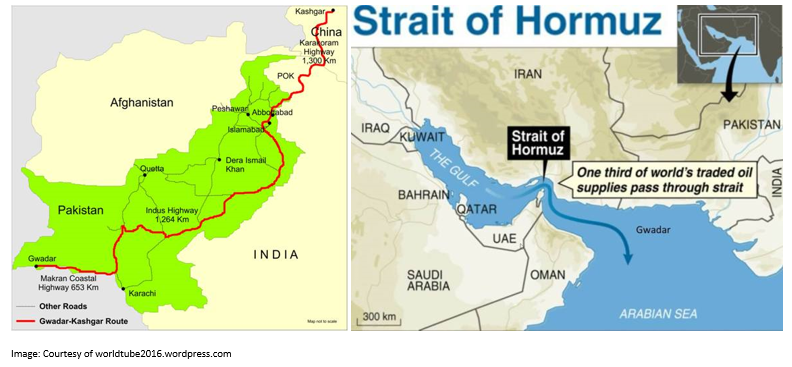
Chinese is also looking to build gas/oil pipeline from Gwadar up north running through the length of Pakistan through Pakistan Occupied Kashmir (POK) & into the western Chinese province of Xinjiang. This is to have insurance against any closure of Malacca Straits by India or other adversaries where they could bring the gas/oil to Gwadar & transport it by pipeline thus passing the chokepoint Malacca Straits. However many believe that this option is beset with difficulties because of geographical, economic and security problems plus cost of this land based route vs maritime shipping . Due to the poor relations between India & Pakistan India doesn’t have much leverage here.
SRI LANKA:
Sri Lanka since its independence in 1948 has had close relations with India. The Tamil population (who were in minority) were feeling marginalized by the majority Sinhalese. Groups were formed to protest this & some of these groups eventually morphed into the LTTE militant group. India intervened in Sri Lanka in 1987 when it sent troops to SL as part of the Indian Peace Keeping Force (IPKF) which was withdrawn few years later after disastrous results. India mostly abandoned support for the LTTE once it came to light that they were responsible for the assassination of former PM Rajiv Gandhi who had sent the IPKF to Sri Lanka. The seminal event in modern Sri Lankan history came in 2005 when Mahinda Rajapaksa came to power. Over the next few years he led a hard fought campaign to finally suppress the LTTE for once & all. This bruising campaign where there were allegations of human rights violation meant that Rajapaksa became a pariah in the West who now refused to sell weapons to SL for the war effort. When Sri Lanka turned to India as always for help back then the UPA-I coalition government was in power in New Delhi. The ruling Congress party elite & the bureaucrats were not averse to helping Sri Lanka but were caught up in a bind due to domestic compulsions as openly supporting Rajapaksa meant angering it’s its coalition partner DMK. The threat perception of DMK chief Karunanidhi possibly bringing down the UPA government meant New Delhi helped Sri Lanka with mostly intelligence gathering & sale of some non-offensive defense equipment mostly under the radar. This meant that for its offensive weapons needs Sri Lanka turned mostly to China. Thus began the Sri Lanka’s phase of drawing closer to China. Once the war ended Rajapaksa wanted to move the country forward after decades of civil war by turning to infrastructure building towards achieving higher economic growth & prosperity. The goal was to improve the infrastructure in Sri Lanka via construction of new roads, airports, ports, container terminals, railways etc. Already at odds with the Western countries over the handling of the civil war, he found a willing partner in China who was more than eager to dole out vast sums of money to Sri Lanka. By some estimates it was found that Sri Lanka had tripled its national debt with these projects financed by China. Later on it was found that many of these deals had very high costs associated with it & there are allegations of wide scale corruption when these deals were awarded to various Chinese groups & banks.

Image: Courtesy of stripes.com
One of these multiple infrastructure projects was in Hambantota, a small costal village in the south of Sri Lanka & also the hometown of Mahinda Rajapaksa. His dream was to construct a new modern city which also sits strategically in the south of the country along the sea lanes between West Asia & South East Asia. Chinese companies were given contracts to build a new deep sea port, airport, conference center, housing developments, and hotels and (since SL a cricket playing nation why not) an international cricket stadium. However once the projects were finished Sri Lankans soon realized that it was as a complete disaster with hardly any ships coming to the port & flights coming to the airport. This affected the revenue stream which meant that there wasn’t money to cover the payment for the $1.4 billion loans. By 2015 Sri Lanka owed to China $8 billion for Hambantota & other projects. The foreign debt to China & other countries was equal to 94% of Sri Lanka’s GDP while payments to all these loans were accounting for 95% for all revenues generated by the country. Staring at this financial nightmare the new government (Rajapaksa lost power in 2015) last year did a debt for equity swap for Hanbantota port where Sri Lankan Ports Authority gave up 80% equity to China Merchants Port Holdings Company in a 99 year lease in exchange for $1.1billion dollars which will help facilitate the loan payments. Further 50sq km was to be given to Chinese companies to create LPG plant, factories, refinery to create a sort of an SEZ (Special Economic Zone). India which already had been alarmed by Chinese submarines showing up in Colombo port in the past few years was now up in arms. The worry was that once China controlled Hambantota they would establish a naval base from where they would now a strong foothold to operate in the Indian Ocean Region exercising control over the vital sea lanes passing south of Sri Lanka. Sri Lanka has on multiple occasions has maintained that it will never allow Hanbantota port to be used by military vessels of foreign nations. Many in India still doubt that when “push comes to shove” & the Chinese dock naval vessels at Hambantota if the Sri Lankans will be able to prevent it from happening. The airport at Hambantota has been ridiculed in the press as being the “world’s most emptiest airport” which has just couple of daily flights. To counter China the Indian government last year has proposed buying out the Chinese loans for the airport from Sri Lanka in exchange for a 40 year lease of the airport at cost of $300 million. This will give it capability to do aerial surveillance of the port area to keep an eye on the Chinese activities & discourage China from converting it to a naval base in future. India was basically forced because of its strategic interests to spend $300 million on the “world’s emptiest airport”. To counter Chinese influence Modi government in 2017 had proposed to develop Trincomalee port in the north of the country, railways lines & power plants (while the Japanese had sought to develop the Colombo port). Sri Lanka’s new president Maithripala Sirisena when got elected in 2015 promised to relook at these shady infrastructure deals with the Chinese & cancel the ones where there was corruption or were not in best interests of the country. But the debt for equity sale in Hambantota shows that Sri Lanka is unable extricate from the mess of the Chinese debt. The new regime in Colombo has managed to stabilize the situation with the debt for equity swap & getting an IMF loan but it could again quickly go downhill in the future if either economic condition deteriorates & more loans go sour.
MALDIVES:
Maldives is a small littoral state just south of Lakshadweep islands in the India Ocean. They sit just south of the crucial shipping lanes in the India Ocean. Traditionally it has been in the Indian sphere of influence till recently. In 1988 when a coup d’état attempted by hired mercenaries overthrew President Gayoom then Indian PM Rajiv Gandhi dispatched 1,600 troops to restore the status quo in Maldives. India received gratitude & praise from both Maldivians & Western powers alike for this quick & prompt military action.
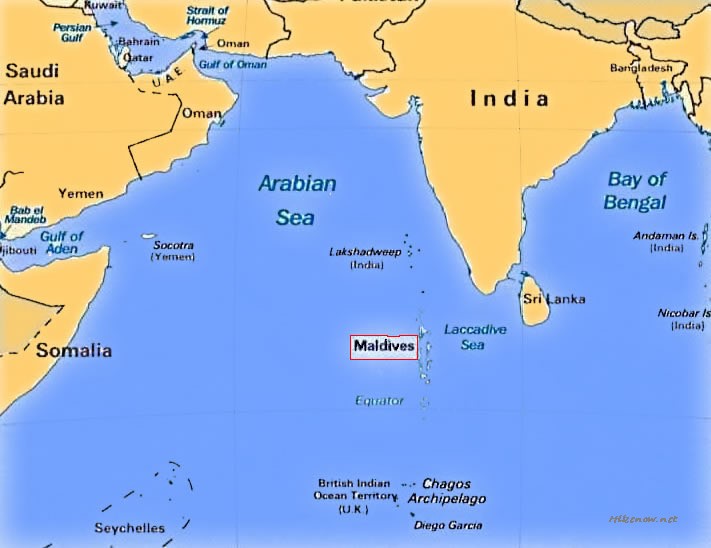
Image: Courtesy of hikenow.net
In 2008 in the first ever democratically held elections Gayoom was defeated by Mohamed Nasheed. Nasheed was later forced to resign in controversial circumstance in 2012 which he claims was at gunpoint. In the subsequent elections in 2013 current president Abdulla Yameen defeated Nasheed. Yameen has slowly turned his rule into more of a dictatorship where he crushed dissent & jailed opponents. This reached its climax in Jan 2018 when Supreme Court removed terrorism charges against opposition figures & Yameen in turn declared emergency arresting two Supreme Court justices. He even went to the extent of arresting his own half-brother & former president Gayoom. Nasheed who was in exile abroad escaped incarceration. USA, India & several other countries have issued strong statements for the “respect of the rule of the law”. Indian unlike 1988 can’t just simply launch a military operation to restore order because the situation has changed partly due to presence of China. China has issued a veiled warning against foreign intervention in Maldives (implied threat against Indian military operation). For the past few years be it the cancelling of Male airport project ($500 million) & awarding it to the Chinese or singing of a free trade agreement in complete secrecy & rushing it through parliament in middle of night, Chinese influence has grown in Maldives. With the military option off the table India is hamstrung with a lack of good options. India & the western countries can impose hard hitting sanctions but Maldives depends on China & also Saudi Arabia for funds which means the sanctions would lack any real bite unless enforced simultaneously by Saudi Arabia & China. Yameen is no friend of India & is not going to change his behavior anytime soon. Nasheed has claimed that China has already taken over 16 islands & has been quoted as saying “Without firing a single shot, China has grabbed more land than the East India Company at the height of the 19th century”. Last month it was reported that China was going to setup an oceanic station on a northern Maldives island close to India. This means that they can track movement of surface ships & submarines passing just south of Indian peninsula thus further eroding India’s advantage in this region. Modi has made it a point to visit all SAARC countries except Maldives (even Pakistan was visited on brief stopover on Nawaz Sharif’s birthday in 2015 Dec) as snub to the regime being anti-India. India to punish Maldives has decided to switch its vote for a non-permanent member of the UN Security council from Maldives to Indonesia in a upcoming session of the Security Council. However it is yet to be seen if any of the sanctions, diplomatic pressure & change of the UN Security Council vote can bring any substantial change in Yamen’s behavior. The only advantage India have is the geographical proximity to Maldives which means India can land troops if necessary in Male within a couple of hours while Chinese ships while sailing from mainland China would take more than a week.
NEPAL & BHUTAN
Nepal suffered greatly during a civil insurgency by the Maoists from 1996 onwards. The civil war ended 10 years later when they signed a peace accord & joined mainstream politics. A couple of years later the monarchy which ruled Nepal for 240 years was abolished & Nepal became a republic. Modi did visit Nepal twice early in his term & promised $ 1 Billion worth of India investment much of which is yet to come to fruition. India also received praise for the speedy help during the 2015 earthquake which devastated the countryside. The main complaint which many in India’s neighborhood have is that India makes tall promises but don’t deliver. When Nepal was working on a new constitution in 2015, India tried to pressure Nepali elite living in the hills to accommodate the demands of the Madhesi population living in the plains & adjoining the border with India (who are considered close to India). When the demands were not met the people in the southern plains blocked transportation of crucial supplies from India (including petrol) to landlocked Nepal as a form of protest. Many living in the northern hills believe that this protest had the tacit support of India government. Eventually the blockade was lifted without any major concessions which resulted in the people in the plains not getting most of their demands while driving up anti India sentiment among the hill folk. In the ensuing election communist leader K.P. Oli who is pro-China came to power replacing the former PM who was seen to be more pro India. Nepal like many countries in Asia is desperately looking for infrastructure building & has seen a huge spurt of Chinese investments which accelerated after Oli took power. Nepalese often complain that India tries to interfere in the inner working of Nepal, a leftover mentality they say from the days of the British Raj. Nepal sandwiched between two Asian giants does try to balance out influences from both neighbors but the blockade fiasco simply drove up the anti-India sentiment in Nepal causing India to lose influence in Kathmandu. Nepal in short has been a failure for the current government as it has drifted out of India’s orbit for now.
Bhutan after the annexation of Tibet by China signed a Friendship Treaty which established very close relations with India. Bhutan is required to consult with India in matters of defense & security. Bhutan is only neighbor of China with which it has not established close relations. The Dolam plateau episode as I explained last year was to drive a wedge between India & Bhutan. China is desperate to get a foothold in Bhutan to move it away from Indian sphere of influence but Bhutan has uptill now under great duress avoided all Chinese overtures. After the Dolam episode Indian government quickly reworked the hydropower agreement at higher tariffs (which had been Bhutan’s demand from some time) to keep it happy in face of renewed Chinese pressure on Bhutan. Foreign Secretary Vijay Gokhale, National Security Advisor Ajit Doval & Chief of Army Staff Bipin Rawat made quiet trips to Bhutan just this February to send a firm message that India stands with its ally Bhutan. Bhutan to this day remains India’s best friend in the neighborhood a fact not lost on PM Modi who made Bhutan his first foreign visit after being sworn in 2014. PM Modi pushed for the BBIN (Bangladesh Bhutan India Nepal) MVA Motor Vehicles Agreement that will allow easy transit of personal & cargo motor vehicles with help of electronic tracking & online permitting sent to all land based ports. This will allow seamless transport of goods across all countries to improve l connectivity, cross border trade & regional integration. Even though Bhutan has opted out the hope is for rest 3 countries to start operation this coming April.
BANGLADESH & MYANMAR
Bangladesh & Myanmar are two of India’s eastern neighbors connected to India’s North East. Both of these countries have multiple OBOR infrastructure projects ongoing in their countries. Kyaukphyu a port being developed as part of OBOR in Myanmar is part of the concern for India as it could become another Hambantota or Gwadar giving China a foothold in the Bay of Bengal. India always has had connectivity issues with the North East (which now due to tensions with China especially at border has become of vital importance) due to terrain & geographic issues like the Siliguri corridor. It is of strategic interest that India open alternate routes to connect North East via ports in from Myanmar & Bangladesh. Bhutan whose main export is hydropower is always looking for new avenues to export more electricity. India could facilitate extending the transmission lines through the North East to both Bangladesh & Nepal thus creating a win-win situation where Bangladesh can fulfil her power supply needs while Bhutan can generate more export revenue plus not to mention goodwill for India. As part of the Act East policy by the Modi government India speeded up work on the 1360km (India Myanmar Thailand) Trilateral Highway to improve connectivity & boost trade between India & Myanmar &. The goal is to complete the highway by December 2019.
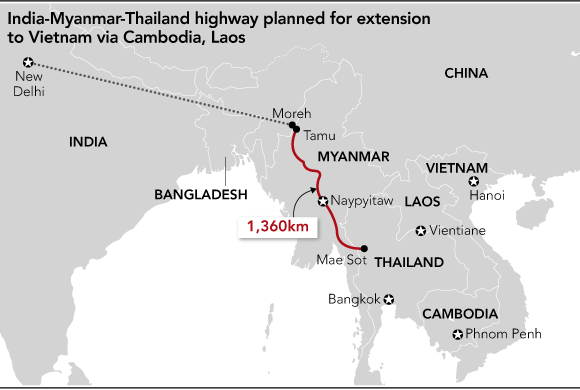

Image: Courtesy of asia.nikkei.com
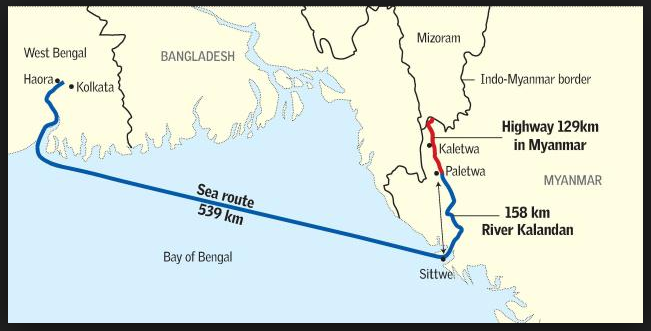
Image: Courtesy of bestcurrentaffairs.com
Currently to transport goods from West Bengal to Mizoram in North East one has go through the narrow & congested Siliguri corridor. The Kaladan Multi-Modal Transit Transport Project being undertaken by India is to connect Kolkata by sea route to Sittwe in Myanmar & then by land to Mizoram in the North East which will significantly reduce time & cost. However like many of India’s infrastructure projects in the neighborhood this too has been beset by delays & is yet to be completed.
India has enjoyed good relations with Bangladesh with current PM Sheikh Hasina (daughter of the founder of the nation). The land boundary agreement signed in 2015 (which has been in limbo for decades) helped further improve relations. India late last year gave Bangladesh a $4.5 billion dollar credit at a very low 1% rate to be paid back in 20 years (with a 5 year grace period if needed) to develop infrastructure in 17 pre identified projects such as power , railways roads & ports & help move Bangladesh away from Chinese funding. There was a $500 million line of credit for military hardware purchases, to steer Bangladesh away from relying on China for defense purchases. India in an unprecedented move has joined hands with Russia to setup a civilian nuclear reactor facility in Bangladesh.
AFGHANISTAN & CENTRAL ASIA
India after independence due to loss of territory in Pakistan Occupied Kashmir found itself cutoff from Afghanistan & Central Asia. Post 1962 after the war with China any possibility of a trade route through Tibet & western China also evaporated. As in the great game Central Asia was a region where the influence of the erstwhile Soviet Union & now Russia looms large. China’s economic prowess has allowed it to make forays on the economic front in Central Asia. Russia while facing a threat from US including crippling sanction requires co-operation from China both politically & also in the economic sphere where it needs to sell oil & gas to China to generate much needed revenue to keep its economy afloat. Russia for time being has not raised any objections to the Chinese investment in this region (which it considers its own “backyard”). Afghanistan since the withdrawal of Soviets has been an unstable failed state. Pakistani military wanting to exert influence in Afghanistan propped up the Taliban in the 1990’s to maintain their hold over the country. The US invasion post 9/11 brought end to Taliban rule but through covert support to the Taliban through Haqqauni network, Pakistan has continued to meddle in the internal affairs of Afghanistan. Afghanistan has always enjoyed warm relations with India (except during the Taliban rule). The schizophrenic Pak military establishment cannot digest good relations between India & Afghanistan & try to scuttle this affability between its eastern & western neighbors. In Dec 2015 the new Afghan parliament building was built with Indian aid. Indian projects in Afghanistan have proved tricky as they invariable attract the attention of Taliban – Pakistani military nexus which tries to disrupt or scuttle them with threats & terrorist attacks. When India wanted to trade with Afghanistan through the land route post 2001 they were denied by Pakistan. India then smartly decided to go around Pakistan by using Chabahar port in Iran. India in 2016 offered to develop the Chabahar port in Iran from which they planned to construct a road to the border with Afghanistan. The port was inaugurated late last year & the first batch of wheat was shipped from India to Afghanistan via Chabahar bypassing the need to go through Pakistan. The success of this route (in bypassing Pakistan) can be partially gauged by the volume of hysteria it generated in Pakistani media lamenting “the waning of Pakistani influence” when the route opened up last year. A future goal is to have Chabahar port connect up with the INSTC (International North South Transit Corridor). Goal of this corridor is to connect India with the markets in Central Asia, Europe & Russia via shorter route compared to the standard sea route vs the Suez Canal. Once completed it would cut short the transit time by this land route (Suez Canal) by upto 20 days vastly reducing costs

Image: Courtesy of Wikipedia.com
PM Modi understanding the importance of Central Asia became the first PM to visit these countries in a very long time. He visited all 5 Central Asian Soviet republics of Uzbekistan, Kazakhstan, Turkmenistan, Kyrgyzstan & Tajikistan in a single trip. Goal of the trip was to improve the paltry $1.2 billion trade with the region, improve connectivity via INSTC (International North South Transit Corridor) TAPI (Turkmenistan Afghanistan Pakistan India) gas pipeline. He was able to get commitments of 5,000 & 2,000 tonnes of uranium respectively from Kazakhstan & Uzbekistan to cater to India’s growing civilian nuclear energy needs. India a few months ago was invited to join the Ashgabat Agreement, which was instituted in April 2011 to establish an international multimodal transport and transit corridor between Central Asia and the Persian Gulf. Its objective is to enhance connectivity within the Eurasian region and synchronize it with other regional transport corridors, including the International North–South Transport Corridor (INSTC).
ASEAN/SOUTH EAST ASIA
Post economic liberalization in the early 90’s former PM PV Narasimha Rao launched the “Look East” policy to increase economic & security cooperation to deepen ties with countries in South East Asia. When the current government came to power in 2014 they launched a revised “Act East” Policy. One of the plans is to extend the Trilateral Highway beyond Thailand upto Cambodia, Laos & Vietnam thus connecting India to all the land based nations of ASEAN. India has also offered $1 Billion in loans for infrastructure projects in the ASEAN region. India during the Republic Day usually hosts one foreign head of state (with some exceptions). This year saw India in a huge diplomatic coup inviting all the 10 heads of state of ASEAN during the Republic Day parade as chief guests. This was in backdrop of the India ASEAN summit in New Delhi where a whole host of issues on regional connectivity, trade & security were discussed.
The vast majority of nations in the Asian have territorial disputes with China in the South China Sea. South China Sea has several small islands which are in between two or more countries in the region. They have never been demarcated by the neighboring countries due to the disputing claims. Most of these have been uninhabited uptill few years ago when China began to aggressively to move on to these islands & building permanent infrastructure to colonize these islands. This militarization of these islands by China is part of a plan to then eventually convert the South China Sea into a Chinese controlled water body where they can deny both sea & air access to any friend or foe. They have claimed all the territory within an arbitrary “9 Dash Line” which is based on bogus historical claims. The Unite Nations Convention on Law of the Sea (UNCLOS) says that a country can claim an exclusive economic zone upto 200 miles from its shores. China has willfully ignored any such convention while trying to take over this territory in a brazen land grab. It has actually claimed territory which is much closer to its neighbors than itself which also defines a logical equidistant boundary principle. Phillipines took its case to the tribunal at Court of Arbitration at Hague which ruled in its favor saying China has no legal basis to claim the infamous “9 Dash Line” in the South China Sea. China called the ruling “null & void” without “binding force” & continued to stand by its claim. Malaysia, Brunei, Philippines & Vietnam due to their economic & military asymmetry haven’t stood up to China’s bullying. It has been left to United States to sail ships every so often through the South China Sea calling it a Freedom of Navigation Operations (FONOPS). Even though this region is far away from Indian shores but due to India’s trade with the Far East including Japan depends on freedom of navigation through the South China Sea it is a significant issue for India.
Singapore has the closest defense relationship with India in the region. India already had Army & Air Force Bilateral agreements in place & signed in 2017 the naval pact which would now allow India warships to dock in Singapore which is crucial as it sits in the strategically important Malacca Straits.
Vietnam fought a war with China in 1979 & is one of the countries with one of the most anti-China sentiment in this region. Crucially India has enjoyed good relations with Vietnam. Vietnam is viewed by many in China as a counterweight against China similar to what China uses Pakistan against India. Vietnam has openly encouraged India to jointly explore & invest the oilfields in South China Sea (in dispute with China). India had given a $500 million line of credit to purchase military equipment in 2016. With Vietnam also having a large no. of Russian weapons in its arsenal India has provided a good source of weapon procurement & training. Just a few days ago when the Vietnamese President visited India a deal was signed for civil nuclear energy cooperation & for India to develop a port in Vietnam. There were some talks a couple of years ago about selling the supersonic cruise missile Brahmos to Vietnam. Some analysts have proposed that India shed inhibitions about Chinese blowback on this matter as China regularly sells weapons to Pakistan without taking into account Indian sensitivities. Selling Brahmos missiles to Vietnam will send a strong message that if China is going to actively engage with India’s neighbors in the IOR, India is not averse to doing the same in China’s own backyard.
JAPAN, AUSTRALIA & THE “QUAD”
Japan is another of China’s neighbor that it has had territorial disputes with. The dispute is over the Senkaku islands in the East China Sea. Japan fought & conquered parts of China in World War 2 & the relations are still strained due to the Japanese invasion & atrocities during the Japanese rule then. The mutual distrust & hatred for each other is present on both sides of the China Sea. The rise of China in the recent times has caused much consternation in Tokyo. Post World War 2 Japanese constitution included an amendment (Article 9) that prohibits Japan from keeping offensive armed forces for war (to prevent a repeat of the legacy of World War 2 when Japan invaded multiple countries in Asia) i.e. Japanese armed forces are strictly for “self-defense”. The Chinese threat has led PM Shinzo Abe to propose changing the constitution to get rid of this Article 9 a thought unthinkable even just a few years ago. This has drawn protests from the Chinese who suffered during the Japanese occupation in World War 2. Modi after the travel visa ban by the US & Europe became a pariah in the West. Modi looked east while he was CM of state of Gujarat for investments & found a willing partner in Shinzo Abe one of Modi’s earliest overseas friends. The warm camaraderie shared by both is reflected in the very close Indo Japanese relationship today. Japan has decided to loan India $17 billion at an extremely low 0.1% interest rate which is to be paid back in 50 years for construction of a bullet train between Mumbai & Ahmedabad.
Many nations around the world suffered during one or more the major financial shocks of last 30 years: Asia financial crisis, Dot-com bubble, post 9/11 recession & global financial crisis of 2008. Australia has been a major global outlier which has survived all of these events (no recession since 1991). It enjoyed the increase in exports of commodities to China to power its growth without experiencing a recession. Today China is Australia’s biggest export destination $93 billion (4.5x next closest one US at $20 billion). Since Australia is island all of its exports are via sea & the issue of FONOPS (Freedom of Navigation) is of paramount importance to it. Around a decade ago when The QUAD a strategic dialogue between India, US, Japan & Australia was proposed but Australia eventually bowed out as it wanted to stay neutral between US & China. Overt last few years there have been quite a few exposes about the Chinese infiltration of the political institutions of Australia. . Australian PM Malcom Turnbull was forced to bring in new laws on espionage & intelligence due to this belated realization of massive Chinese penetration in Australia. On a separate front Chinese foreign students in Australia have become more vocal in protests pressuring professors to drop or alter teaching material on subjects like Tibet, Taiwan, border dispute with India, etc. that they deem as offensive to China. Frederic Grare, a fellow at the Carnegie’s South Asia Program in his book India Turns East rightly says that Australia will soon have choose between its economic partner China & it’s security partner US (with which it shares a military alliance). Ten years later woken up by the Chinese threat Australia signaled its willingness to join the QUAD as counter balancing force to the Chinese threat. The main theme of the QUAD is to have “free and open Indo-Pacific,” (referring to Indian & Pacific Oceanic region encompassing the disputed South China Sea) Goals for the QUAD include a rules-based order in Asia, freedom of navigation and overflight in the maritime commons, respect for international law & enhancing connectivity & maritime security. The common perceived threat from China has brought together 4 democratic “like minded countries” from three different continents together to uphold rules based order. US the 4th member in the QUAD has warily seen the rise of China from across the Pacific Ocean. During the Obama administration there was the famous “Pivot to Asia” but they avoided calling it a bid to contain the Chinese as to not raise Chinese hackles. Trump administration has made the right noises about standing up to China & FONOPS but they can’t press China too hard as they need their cooperation on North Korean nuclear issue. Quad is movement by various countries who know that it is not possible for them to deal with the Chinese threat by themselves joining hands to keep China in check.
Editor's Note: The Maps shown in the images are shown by the author for illustrative purposes and are referenced from sources. MyIndMakers is not responsible for the maps shown, the sources for the maps are listed below.



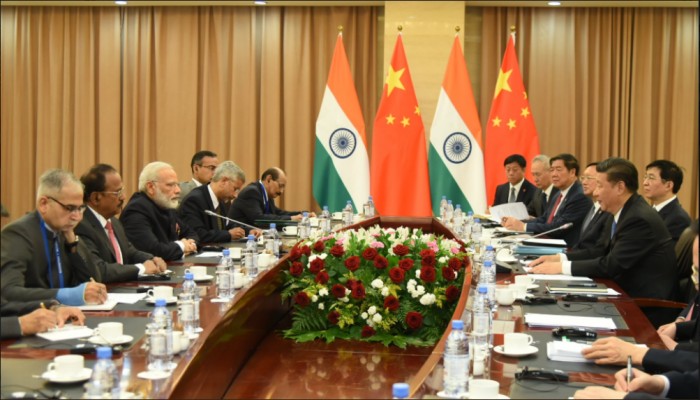



Comments